Training Room 1: First Steps to Safety—Understanding Hazards
Promoting Farm Safety
Session 5: Identifying Agricultural Hazards—Livestock Safety
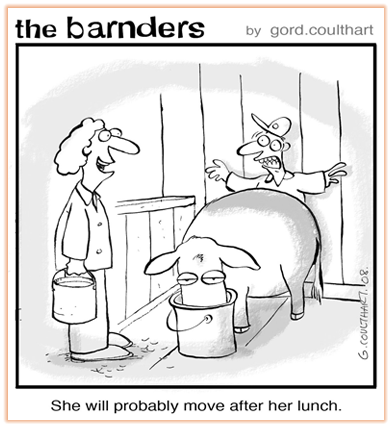
Courtesy of Gordon Coulthart and The Canadian Agricultural Safety Association
Statistics indicate that farm machinery and livestock are involved in the majority of all farming injuries. According to Alberta Agriculture and Rural Development, approximately half of all farm-related injuries in Alberta involve large animals, including cattle and horses. Livestock behaviour needs to be understood by all workers so that the animals experience minimal stress. Awareness will also help to minimize hazards, resulting in a safer work environment.
Learning Target
In this session you will learn to describe the potential hazards related to animal management on a farm. Consider these questions as you go through this session:
- What makes working with livestock so hazardous?
- How can you best prepare yourself to be aware, safe and injury-free when working with animals?
How Hazardous Are Those Critters?
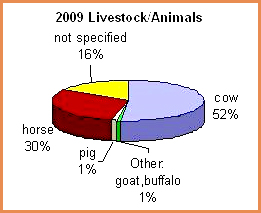
Alberta Farm Safety. Used with permission.
This graph, from the 2009 Alberta Farm Injury Report, shows which animals are most often involved in handler injuries. Handlers incur these injuries by:
-
being kicked, stepped on or crushed
-
being hit by gates as they open
-
having fingers, hands or arms pinched by gates and chutes as they close
-
slipping and falling because of wet floors and slippery corrals
-
being cut or jabbed by veterinary instruments
-
falling off of horses.
Watch and Listen
Watch the video from Farm Safety: It's No Accident to better understand the most obvious livestock-handling hazards.
Click here for the video: Livestock-Handling Safety Video
Livestock-Handling Hazards
Understanding animal behaviour plays a large part in keeping yourself safe. Animals see their environment differently than we do. For example, rapid movement can activate fear in animals.
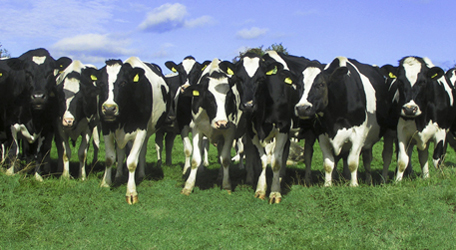
© James Murphy/900744/Fotolia
Fear and aggression are displayed by
- raised or pinned ears
- raised/swishing tail
- raised back hair
- bared teeth
- pawing/stomping the ground
- snorting
Watch and Listen
Safe Animal Handling
Watch these videos and do some research on your own to learn how your awareness of animal behaviour and proper handling techniques can reduce hazards.
- Choose one of the following two videos from Alberta Agriculture so that you can learn about and describe appropriate ways to handle a particular farm animal:
- Cattle Handling Part 1 (on YouTube: AlbertaAgriculture's Channel – and enter Cattle Handling in the search box)
- Horse Safety: Instincts, Handling, Equipment (on YouTube: AlbertaAgriculture's Channel – and enter Horse Safety in the search box)
- Cattle Handling Part 1 (on YouTube: AlbertaAgriculture's Channel – and enter Cattle Handling in the search box)
- Learn from 4-H students in this video of how to increase your awareness of Safe Animal Handling. (This one takes a while to load.)
- Search the web to find information on handling the kinds of animals you encounter regularly on your agricultural worksite. (This could include a variety of livestock or working farm pets, etc.)
Be prepared to use your knowledge in the assignment, Safe Animal Handling, described below.
Organizing Knowledge
Understanding an Animal's Sense of Space: Appropriate Ways to Approach an Animal
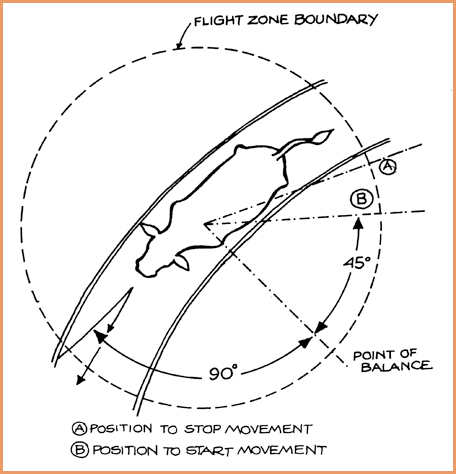
Courtesy of the CFA and The Canadian Agricultural Safety
In order to safely handle an animal, it is important to understand how to manage the space around it. Moving effectively in and out of an animal's flight zone, controlling movement by adjusting your position in front of or behind the point of balance, and staying out of the animal's blind spot are all skills for safe animal handling.
The flight zone is an animal's personal zone. Each flight zone will depend on that individual animal and how calm or stressed it is. When a handler enters an animal's flight zone, the animal will move away.
The point of balance is at the animal's shoulder within the flight zone. Generally, animals will move forward if the handler is behind the point of balance or backward if the handler is in front of the point of balance.
The blind spot or kick zone is the area where animals can kick you. Avoid the kick zone by approaching an animal from the side, ensuring the animal can see you. Generally animals will turn to look at what is entering their kick zone.
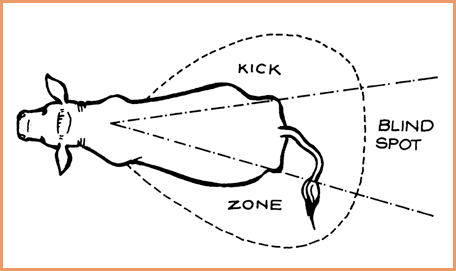
Courtesy of the CFA and The Canadian Agricultural Safety
From Animal Safety. Publication by Government of Alberta: Agriculture and Rural Development
Use your knowledge of Safe Animal Handling to guide the animal safely towards its pen.
Resources for Further Information
Refer to the following PDF documents for more information and images about approaching and handling animals.
- Cattle Handling: Work Smarter, Not Harder by the Ontario Farm Animal Council
- Agri-Facts: Handling Livestock Safely by Alberta Agriculture, Food and Rural Development
Time to Practise
Take a moment to reflect on what you've learned about livestock handling. Using the information above and your experiences with livestock, you will demonstrate your understanding of how to safely handle an animal.
Assignment—Safe Animal Handling
Your task: Animal Handling Assignment
Demonstrate your understanding of the hazards associated with animal handling by providing an example of how you would handle a farm animal of your choice at an agricultural worksite.
Include responses to the following questions:
- What you would look for to determine if the animal is hazardous?
- How would you approach the animal with safety in mind?
- How would you best use your understanding of the animal's personal space to maintain control?
- Are there any special precautions you would take to keep yourself safe?
You can choose from any of the following ways to demonstrate your understanding, or develop a product of your own in consultation with your teacher:
- a written description of the animal-handling event
- an audio clip describing the animal-handling event (MP3)
- a labelled diagram, which may be hand-drawn, scanned, or developed on illustration software
- a video clip demonstrating your work with an animal or a video of an animal-handling event with your narration
Tools
Use this Demonstration Animal Handling Assignment rubric to support your work.
Submission
Submit your Safe Animal Handling Assignment to your teacher.